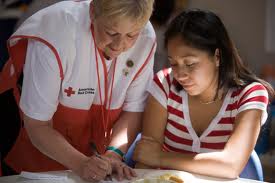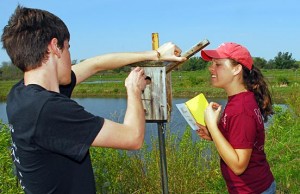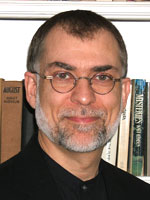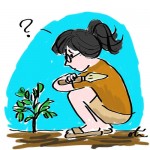 The U.S. population is aging as the baby boomers begin reaching their golden years. This means our nation is facing more people with the declining function, memory and cognition associated with aging. [Read more…]
The U.S. population is aging as the baby boomers begin reaching their golden years. This means our nation is facing more people with the declining function, memory and cognition associated with aging. [Read more…]
New evidence on volunteering later in life
Mentoring works for troubled, but how?
Evidence needed: The effect of volunteering on health
 Here at EBL, we’ve written before about the impact of volunteering on public health. In fact, Cornell gerontologist Karl Pillemer has conducted research that found that older adults who get involved in creating a sustainable society are not only helping the environment, they are also helping themselves. So we were interested to find a new systematic review on the health and survival of people who volunteer.
Here at EBL, we’ve written before about the impact of volunteering on public health. In fact, Cornell gerontologist Karl Pillemer has conducted research that found that older adults who get involved in creating a sustainable society are not only helping the environment, they are also helping themselves. So we were interested to find a new systematic review on the health and survival of people who volunteer.
Youth development that works: Positive findings on the 4-H program
On EBL, we’ve talked a lot about research evidence on problems affecting adolescents, from alcohol use, to video games, to social networking, to sex (I can hear teens who read this starting to hum the tune to “These Are a Few of My Favorite Things”…).
One might ask: Okay, what about the positive side? We’re glad to say that there’s very encouraging news about a program that really works.
One of the most popular and extensive youth programs in the United States is the 4-H program. There are over 6,500,000 members in the U. S. The 4-H program offers activities for kids from 5-19 who are organized in 90,000 4-H clubs. Throughout its history, 4-H has promoted leadership skills, good citizenship, and life skills development. In recent years, it has branched into health promotion programs (like obesity prevention and fostering physical activity) and science, engineering, and technology (“SET”) programming.
All this sounds great, right? But as EBL readers know, we look for the evidence. And now we have it, thanks to the ground-breaking work of Prof. Richard Lerner of Tufts university, one of the country’s leading experts on youth development. Lerner and colleagues expected that the mentoring from adult leaders and the structured learning that goes on in clubs might lead to number of desireable outcomes for children. This led them to do a longitudinal, controlled evaluation of the impact of being a 4-H member. Beginning in 2002, they have surveyed oaver 6,400 teens across the U. S.
The researchers have issued a major new report, looking at the findings on youth outcomes over nearly a decade. To really dig into the results, you should read the very accessible report. Among the many findings, according to the report summary, is that 4-H participants:
- Have higher educational achievement and motivation for future education
- Are more civically active and make more civic contributions to their communities
- Are less likely to have sexual intercourse by Grade 10
- Are 56% more likely to spend more hours exercising or being physically active
- Have had significantly lower drug, alcohol and cigarette use than their peers
- Report better grades, higher levels of academic competence, and an elevated level of engagement at school,
- Are nearly two times more likely to plan to go to college
- Are more likely to pursue future courses or a career in science, engineering, or computer technology
All in all, very impressive findings. So let’s join in the 4-H pledge (can you find the four “H”s?):
I pledge my head to clearer thinking,
my heart to greater loyalty,
my hands to larger service
and my health to better living,
for my club, my community, my country, and my world.
A pretty good approach to living, and one that seems to work for millions of children and teens!
How to convince volunteers to care for trees
 The evidence shows that trees are an important part of our landscape – whether here in forested Ithaca, or in densely populated urban areas.
The evidence shows that trees are an important part of our landscape – whether here in forested Ithaca, or in densely populated urban areas.
Studies have found that trees help improve focus, promote a sense of community, and deter crime. So it’s no surprise that major cities across the nation are launching initiatives to plant trees. New York City is undertaking one such project. Called the MillionTreesNYC initiative, it aims to plant one million trees across all five city boroughs by 2017.
But urban forestry projects typically encounter a problem, explained Gretchen Ferenz, a senior extension associate at Cornell Cooperative Extension in New York City.
“Capital project funds will support planting and immediate care of trees for a couple of years, but costs for longer term care to ensure a young tree’s growth often are not included in municipal budgets,” she told the Cornell Chronicle for a story. “As a result, many urban trees do not survive into maturity.”
Ferenz’s office has joined forces with Cornell’s Department of Natural Resources to create the Urban Forestry Community Engagement Model, a program that provides workshops about the importance of trees to community members in two New York City neighborhoods. The goal is to enlist residents and organizations to become stewards of their community’s trees and, ultimately, to develop resources to help groups around the country do the same.
As part of the program, they’re collecting evidence to learn how to get more community members involved in caring for trees in their neighborhoods. They recently published a study that examines motivations and recruitment strategies for urban forestry volunteers.
Through a survey and focus groups, as well as a review of existing literature on the topic, the team found volunteer who plant and care for trees in their communities are motivated by a wide range of factors. And most have a limited knowledge of the benefits of urban forests.
This type of work is an important first step in helping cities learn how to engage community members to help care for trees in their neighborhoods – and ultimately in making our world a bit greener.
(You can learn more about the Urban Forestry Community Engagement Model by clicking here.)
Democracy and higher education: A discussion with Cornell prof Scott Peters
 Cornell education professor Scott Peters has dedicated his career to the intersection between academia and community life. His new book, Democracy and Higher Education: Traditions and Stories of Civic Engagement, examines how higher education contributes to a democratic society. Evidence-based Living sat down with Scott to learn about his vision of Cooperative Extension.
Cornell education professor Scott Peters has dedicated his career to the intersection between academia and community life. His new book, Democracy and Higher Education: Traditions and Stories of Civic Engagement, examines how higher education contributes to a democratic society. Evidence-based Living sat down with Scott to learn about his vision of Cooperative Extension.
What first inspired you to research the topic of the public role for higher education?
“I spent 10 years working for a community-university non-profit that was located on the campus of the University of Illinois. The experiences I had and people I worked with awakened an interest in exploring the history of American higher education’s public mission and purposes. I was especially interested in understanding the origins and meaning of the “land-grant mission.” I often heard people use this phrase like it had some deep profound meaning. But I couldn’t find anyone who could explain exactly what it meant. So I would trace the origins of my interest to those experiences.”
Do you feel that academics have a duty to contribute to democracy and civic life more-so than other professionals?
“I don’t think academics have a duty that is greater than other professions. Professionals in every field and sector of society who want to be what William Sullivan calls “civic professionals” face the same challenge. They have to learn how, as Sullivan puts it, to deploy their technical expertise and judgment “not only skillfully but also for public-regarding ends and in a public-regarding way.” There’s no one “correct” way to do this. But there is a debate about what it can and should look like. I take that debate up in my new book.”
Do you think there are shortfalls in the current higher education system as a whole – that universities, in general, could do a better job of engaging in public life?
“We can and should do much better, yes. But my work has been more focused on illuminating, interpreting, and analyzing the many positive roles and contributions academic professionals and institutions are taking up and making despite the challenges and shortfalls. We give very little attention to faculty members’ civic engagement work. And we devote very little time and space for serious conversation about it. By ‘serious,’ I mean research-based, with robust theoretical and historical groundings.”
Do you have a vision of what the world would look like if engaged professors did a better job of reaching out to help communities?
“I have a vision of what it would look like if we invested more time and attention to understanding and learning from stories of the civic work that professors (and students and staff) are already doing. If we did, there would be a much richer understanding of the public and academic significance of this type of work. We’d see it as a multidimensional activity that has both academic and civic value. But we’d also see it as something that can and needs to be improved. “
Is there anything else people should know about your work?
“I’ve been spending a lot of time investigating the ways the public work of the academy helps to strengthen democracy. That’s helped me to see that things like extension, outreach, and engagement aren’t just “service” activities. They aren’t just about helping communities and solving problems. And they’re certainly not just about transferring information and technologies. At their best they are also avenues for pursuing and improving our teaching and our research. They’re avenues for making better colleges and universities. This isn’t a theoretical hope. It’s being demonstrated every day by civically-engaged faculty, staff, and students at Cornell and elsewhere, and has been for well over a hundred years. One of the most important things I’ve been learning in my research is that engagement work absolutely depends on the development of strong public relationships between the academy and its various external publics. My work is all about helping people to think deeper and better about what it takes to build and sustain these relationships in ways that strengthen democratic processes, principles, and ideals.”
Master Gardener Volunteers: Good new blog, great benefits
We were recently alerted to a new blog about all things Master Gardener, which got us thinking about the program. For those of you who don’t know, the Master Gardner Volunteer (MGV) program is an extension effort based on volunteers who promote public education in horticulture. The volunteers provide educational assistance about trees, lawns, vegetables, ornamentals and a host of other topics. Volunteers go through extensive training, pass an exam, and make a minimum time commitment to the program.
My Cornell colleague Lori Bushway has done a great job of educating me about the MGV program. And I think it’s hard to find a better example of how to harness the power of volunteering. There are over 90,000 Master Gardener Volunteers nationwide, and it’s estimated that they create an annual service value of over $100 million. The benefit to communities is huge and well-documented.
But after our visit from volunteering researcher Mark Snyder, we wondered: What about the benefits to participants? We’d expect MGV participation to be good for the volunteers, but true to our name, on this blog we obsessively look for research evidence.
 Well, from the preliminary research available, it’s not just local gardeners who benefit from MGV, but also the volunteers. First, they get new knowledge. Emilie Swackhammer and Nancy Ellen Kiernan found that MGVs made clear knowledge gains over time in areas like botany, soils, plant disease, integrated pest management, and other areas. In addition, their confidence increased in their ability to answer questions from community members in these areas (here’s the article).
Well, from the preliminary research available, it’s not just local gardeners who benefit from MGV, but also the volunteers. First, they get new knowledge. Emilie Swackhammer and Nancy Ellen Kiernan found that MGVs made clear knowledge gains over time in areas like botany, soils, plant disease, integrated pest management, and other areas. In addition, their confidence increased in their ability to answer questions from community members in these areas (here’s the article).
What about areas beyond horticultural knowledge? T.M. Waliczek and Roxanne Boyer’s article looked at more personal outcomes. They found that MGV training and participation led to increased physical activity, social activity, self-esteem, and other positive effects among Master Gardener volunteers.
Talk about a win-win situation: Volunteers work to improve their communities through promoting citizen involvement in horticulture, and along the way increase the knowledge and quality of life of the volunteers themselves. Go Master Gardener Volunteers!
Want better volunteers? Understand their motivation
We just had a fantastic visit today by Prof. Mark Snyder, Professor of Psychology at the University of Minnesota. Prof. Snyder is a top researcher who also has a strong interest in improving people’s lives in the “real world.” A dominating interest of his is, to put it simply, why people do good things. Why do people help others when they don’t have to, and when it even may not seem in their selfish interests to do so?
 This led him to a two-decades long program of research on volunteering. Research shows that most people endorse volunteering and see it as a good thing. However, only a minority of those who hold this positive value actually volunteer. Prof. Snyder is exploring what can be done to move general motivation into actually volunteering. As part of his research, he has developed the Volunteer Functions Inventory, which identifies main motivations for volunteering.
This led him to a two-decades long program of research on volunteering. Research shows that most people endorse volunteering and see it as a good thing. However, only a minority of those who hold this positive value actually volunteer. Prof. Snyder is exploring what can be done to move general motivation into actually volunteering. As part of his research, he has developed the Volunteer Functions Inventory, which identifies main motivations for volunteering.
You can find out more about his research and intervention programs here. Two points of particular interest for everyone trying to recruit volunteers:
First, volunteers stay on the job longer if their original motivation for volunteering is met. So someone who comes to an organization primarily interested in making friends could best be put in a more social situation, whereas someone coming to explore a new career could get a different set of tasks. The take-home for groups that use volunteers is this: It’s critically important to explore why volunteers want to work for the organization, and to try to match tasks to that motivation.
Second, many of the longest-term volunteers are motivated at least in part by what we might call “selfish” reasons. They want peronal growth, career experience, social contact, or other personally rewarding things. This doesn’t mean they aren’t altruistic — they are that, too. Prof. Snyder coined the term “selfish altruism” to describe this mix of motives. The implication is that it’s okay to want to benefit from the volunteer work, and organizations should feel free to market their volunteer positions that way (focusing on the potential benefits to volunteers).
So Prof. Synder’s work definitely falls in the “research you can use” category. Many of his publications are listed on his web site. He has also created a center that studies positive action, including volunteerism and civic engagement, and it’s well worth a look.




